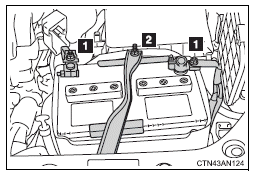 Toyota RAV4: Battery
Toyota RAV4: Battery
■ Battery exterior
Make sure that the battery terminals are not corroded and that there are no loose connections, cracks, or loose clamps.

1 Terminals
2 Hold-down clamp
■Before recharging
When recharging, the battery produces hydrogen gas which is flammable and explosive. Therefore, before recharging:
●If recharging with the battery installed on the vehicle, be sure to
disconnect
the ground cable.
●Make sure the power switch on the charger is off when connecting and
disconnecting the charger cables to the battery.
■After recharging/reconnecting the battery (vehicles with smart key system)
In some cases, the engine may not start. Follow the procedure below to initialize the system.
1 Shift the shift lever to P, and turn the “ENGINE START STOP”
switch OFF.
2 Open and close any of the doors.
3 Start the engine. (If the engine does not start first time, repeat the
procedure.)
CAUTION
■Chemicals in the battery
A battery contains poisonous and corrosive sulfuric acid and may produce
hydrogen gas which is flammable and explosive. To reduce the risk of death
or serious injury, take the following precautions while working on or near the
battery:
●Do not cause sparks by touching the battery terminals with tools.
●Do not smoke or light a match near the battery.
●Avoid contact with eyes, skin and clothes.
●Never inhale or swallow electrolyte.
●Wear protective safety glasses when working near the battery.
●Keep children away from the battery.
■Where to safely charge the battery
Always charge the battery in an open area. Do not charge the battery in a
garage or closed room where there is not sufficient ventilation.
■How to recharge the battery
Only perform a slow charge (5 A or less). The battery may explode if
charged at a quicker rate.
CAUTION
■Emergency measures regarding electrolyte
●If electrolyte gets in your eyes
Flush your eyes with clean water for at least 15 minutes and get immediate
medical attention. If possible, continue to apply water with a sponge or
cloth while traveling to the nearest medical facility.
●If electrolyte gets on your skin
Wash the affected area thoroughly. If you feel pain or burning, get medical
attention immediately.
●If electrolyte gets on your clothes
It can soak through clothing on to your skin. Immediately take off the clothing
and follow the procedure above if necessary.
●If you accidentally swallow electrolyte
Drink a large quantity of water or milk. Get emergency medical attention
immediately.
NOTICE
■When recharging the battery
Never recharge the battery while the engine is running. Also, be sure all
accessories are turned off.
 Brake fluid
Brake fluid
■ Checking fluid level
The brake fluid level should be
between the “MAX” and “MIN”
lines on the tank.
Make sure to check the fluid type and prepare the necessary items.
■ Ad ...
 Washer fluid
Washer fluid
For vehicles sold in U.S.A.
Add washer fluid in the following
situations.
● Any washer does not work.
● The low washer fluid warning
light comes on.
For vehicles sold in Canada
If ...
See also:
Infant and/or toddler seats
Use a safety seat that is recommended for the size and weight of the
child.
When installing a child safety seat:
• Review and follow the information
presented in the Airbag
supplemental res ...
Replacing the batteries
CAUTION
When handling batteries, avoid touching
their contact surfaces as this could result in
poor battery function in the remote key.
3 Note the position of the battery's (+) or (–)
sides ...
Cleaning the seat belts
Use clean, lukewarm water and soap solution.
Do not clean the seat belts using chemical cleaning agents. Do not dry the
seat belts by warming them above 176 ‡ (80 †) or placing them in ...
